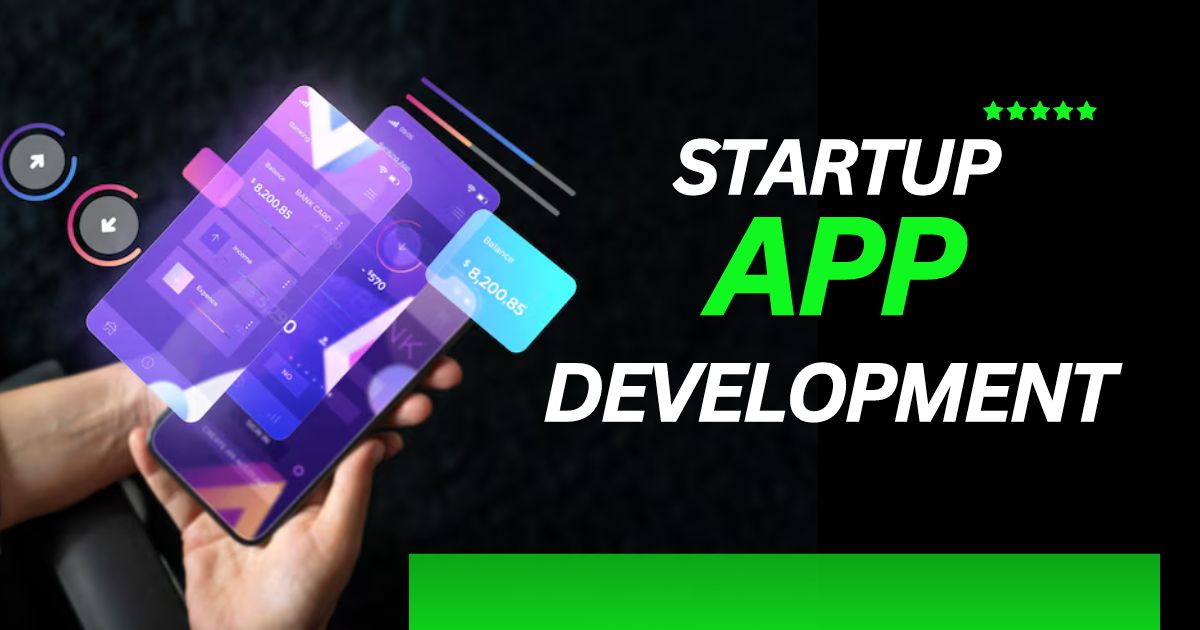In this ever-changing digital landscape, applications become the battlegrounds for start-up companies looking to establish themselves in their marketplaces with promises of fierce competition. Fundamentally, mobile technology complements and enhances human dependence on digital solutions by adding new facets to this high-vibrancy ecosystem, where innovative startup app development design ideas can quickly become viable business strategies.
Startup app development is creating applications that appeal to the needs of a particular set of users within mobile devices, web-based applications, or both. The scope of this activity ranges from an initial idea of what to make and research within the marketplace to design and development and even post-launch maintenance. Ultimately, it seeks to achieve a product that works best for users and identifies a specific pain point for drives in engagement.
Vital Elements of Startup App Development
This includes creativity and market research, which involves an in-depth understanding of the target group, identifying market gaps, and validating ideas through research and feedback.
- Minimum Viable Product: An MVP is an arrangement that enables startups to hit the market early with core features. This will allow the market to be tested and user feedback gathered before investing in full-scale development.
- Technology Stack: Startups must also select the correct technologies for scalability, performance, and low maintenance. They must also consider native vs. cross-platform development.
- Marketing Strategy: A proper go-to-market strategy would give a storm and attract initial users. Pre-launch marketing, social media engagement, and app store optimization are some of those.
- After Launch: Monitor Usage: User Support Activities: Continuous Feedback Based on Usage: Post-Update Action Plan, Quality of update, Updating process based on different kinds of feedback.
Features of a Startup Applications –
When developing an application for a startup, various key features make it usable, engaging, and scalable. Major ones of them include the following:
1. User-Friendly Interface (UI)
The cleanly intuitive design facilitates user experience and makes navigation easy, and any UI shall emerge strictly aligned with branding or the targeting audience.
2. UX Optimization
UX should focus on seamless interactions, minimal loading times, and efficient workflows. Testing can even better reveal what users do.
3. MVP Functionality
Core functionality that solves the most critical problem that the app solves. Thus launching fast while getting early user feedback.
4. Secure Authentication and User Accounts
It involves vital security elements, such as social media login options, email authentication, and two-factor authentication, to protect users’ data.
5. Third-Party Services Integration
Ability to integrate to APIs and other services like payment gateways, analytics tools and social media platforms for enriching functionality and user engagement.
6. Push Notification
Informing updates, promotions or reminders to the users and pushing the association along with user retention
7. Offline Use
Ensuring the availability of basic functionalities even on an internet disconnection makes it useful for users even in low connectivity areas.
8. Analytics and Reporting Tools
Built-in analytics to monitor the application’s user behaviour, performance, and engagement. The information is crucial for the app’s practical use and critical decisions.
9. Mechanism of feedback
Enable easy user feedback through ratings, reviews, and even direct messaging. This will help you understand what users want and how the app can be improved.
10. Scalability
The app’s architecture should be scalable, meaning it must accommodate more new features and add extra user loads without significant overhauls.
11. Customizable Settings
Making preferences like notifications, themes, and other privacy settings easy will help improve user satisfaction.
12. Social Sharing Features
Add functionality that allows users to share content or achievements on social media, which might help promote the app and increase the view count.
13. Search Functionality
Easy searchability allows one to quickly find information or implement functionalities within the application for better usability.
14. Monetization Options
Depending on your business model, ensure your app has features related to in-app purchases, subscription plans, and ad integration to generate income.
15. Maintenance and Updates Regularly
A promise of timely updates on the application with new features, some enhancement of security, and fixing bugs to ensure continued engagement of users.
Development Process for Startup Applications
Application development for startups is structured, and it involves some of the major phases. Below is an outline of the typical phases that startup application development entails:
1. Idea Generation and Market Research
Identify Problems: Identify a specific problem or need in your target market.
Market Analysis: Identify competitors, trends in the market, and insights about potential users.
User Personas: Rich, complete profiles of your target users guide the design and functionality.
2. Defining Requirements
Feature List: The essential features and functionalities of the Minimum Viable Product, which directly maps to user needs
Technical Details: Technical requirements- selection of the platform – iOS, Android, web and technology stack
3. Prototyping and Wireframing
Low Fidelity Wireframes: Low fidelity wireframes to visualize layout and navigation
Interactive Prototypes: Clickable prototypes that can replicate user experience and provide early time feedback
4. Design
UI/UX Design: Focus on designing the user interface (UI) and the application’s user experience (UX) to be intuitive, visually appealing, and in line with users’ expectations.
Branding Elements: Apply branding elements such as colours, fonts, and logos to give a strong individuality.
5. Development
Agile Methodology: At this step, an agile methodology is followed with iterative developments and practices. The project would have to be split into sprints, each focused on delivering specific features in each iteration.
Backend Development: This is the development of the server-side infrastructure, databases and APIs that will let the management of data coupled with business logic
Front-end Development: This is the development of the client-side application that users will interact with, with proper responsiveness and compatibility on different devices
6. Testing
Quality Assurance (QA): Carry out unit tests, integration tests, and user acceptance testing (UAT) vigorously to detect bugs that will be fixed
Testing with real users: The user experience usability and functional aspects are tested and adjusted according to the requirements of real users.`
7. Launch
Pre-Launch Marketing: Leverage social media, email marketing, and PR efforts to create buzz around your app in preparation for launch and lay a foundation for anticipation.
ASO: Use keywords, screenshots, and descriptions to gain visibility on the app stores.
Launch Strategy: Decide upon a launch strategy – soft launch to a select audience or full-scale launch.
8. Post-Launch Support
Performance Metrics: Track user engagement, application performance, and bugs that occur using analytics tools.
Feedback from Users: Collect regular feedback from users and reviews that identify areas for improvement.
Upgrades: Schedule upgrades at fixed intervals to detect bugs, introduce new features, and enhance the user experience due to feedback.
9. Scaling and Growth
Scalability measurement: Optimize your infrastructure to meet increasing user loads and data.
Feature Enlargement: New features and upgrades based on feedback and market trends and staying ahead in the application.
Marketing Strategies: Continuously market the product to attract more users while retaining existing ones.
How Can You Generate Revenue From Startup Applications?
Generating revenue from startup apps requires a strategic approach tailored to your target audience and the nature of your app. Here are several effective monetization strategies:
1. Freemium Model
- Basic vs. Premium Features: Offer a free version of the app with essential features while charging for premium features or functionalities.
- In-App Purchases: Users can buy additional content, features, or enhancements within the app.
2. Subscription Model
- Recurring Revenue: Charge users a monthly or yearly subscription fee to access the app or premium features.
- Tiered Pricing: Offer different subscription tiers with varying features and benefits to cater to various user needs.
3. In-App Advertising
- Ad Networks: Partner with ad networks (like Google AdMob) to display ads within your app. You earn revenue based on impressions or clicks.
- Native Advertising: Integrate ads that blend seamlessly with the app content for a less intrusive user experience.
4. Sponsorships and Partnerships
- Brand Collaborations: Collaborate with brands for sponsored content or features, promoting their products within your app.
- Affiliate Marketing: Earn a commission by promoting third-party products or services within your app.
5. E-Commerce Integration
- Sell Products/Services: If applicable, use your app as a platform to sell physical or digital products directly to users.
- Marketplace Model: Create a marketplace within your app where other vendors can sell their products, taking a commission on each sale.
6. Data Monetization
- Insights and Analytics: With user consent, aggregate and anonymize user data to provide valuable insights to businesses and researchers.
- Market Research: Offer insights into user behavior and preferences to companies looking to improve their products.
7. Paid Downloads
- One-Time Purchase: Charge a one-time fee for users to download the app. This works well for niche applications with unique value propositions.
8. Crowdfunding and Donations
- Crowdfunding Platforms: Use platforms like Kickstarter or Indiegogo to raise funds before launch, allowing users to support the app development in exchange for early access or rewards.
- Donation Features: If your app provides significant value, consider adding a donation option for users who want to support its continued development.
9. Consulting and Services
- Offer Related Services: If your app solves a particular problem, consider offering consulting services or premium support for businesses or users.
10. Educational Content and Courses
- Sell Courses: If your app is in the educational space, create and sell courses or premium educational content through the app.
Conclusion!
In conclusion, the success of a startup app hinges on a blend of innovative ideas, solid execution, and ongoing engagement with users. By focusing on these core principles, startups can navigate the complexities of mobile app development and carve out their niche in a competitive market. With the right approach, your app has the potential to not only thrive but also make a meaningful impact in its domain. Feel free to reach out if you have any further questions or need additional insights!



